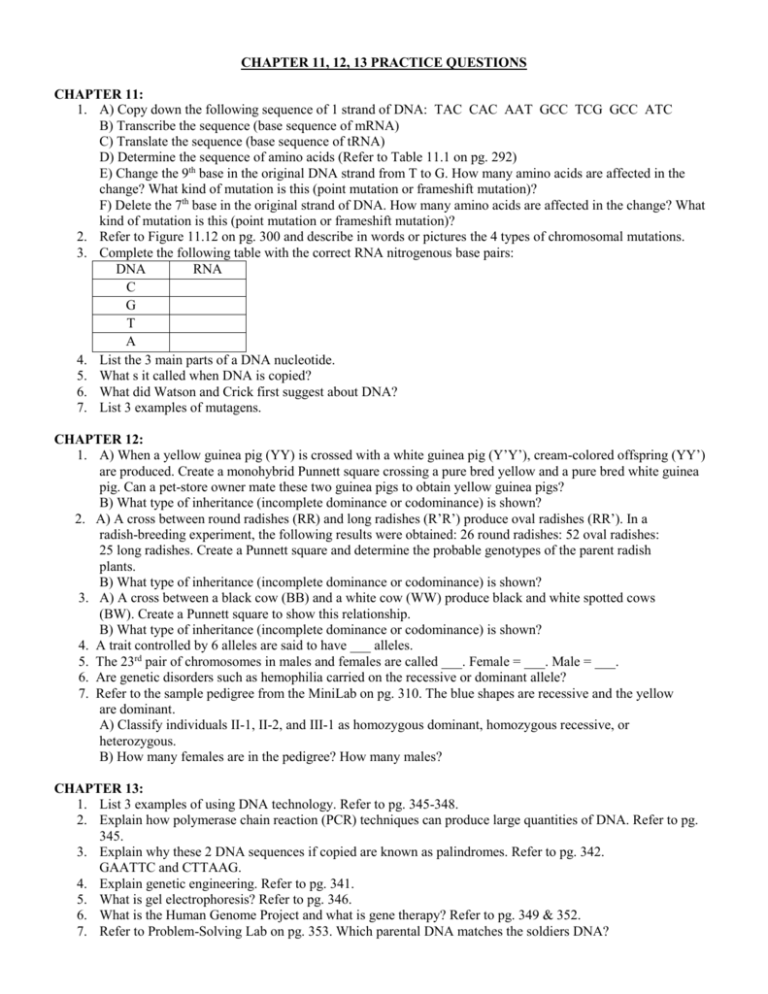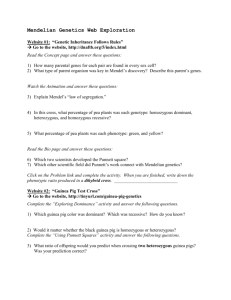CHAPTER 11, 12, 13 PRACTICE QUESTIONS
advertisement

CHAPTER 11, 12, 13 PRACTICE QUESTIONS CHAPTER 11: 1. A) Copy down the following sequence of 1 strand of DNA: TAC CAC AAT GCC TCG GCC ATC B) Transcribe the sequence (base sequence of mRNA) C) Translate the sequence (base sequence of tRNA) D) Determine the sequence of amino acids (Refer to Table 11.1 on pg. 292) E) Change the 9th base in the original DNA strand from T to G. How many amino acids are affected in the change? What kind of mutation is this (point mutation or frameshift mutation)? F) Delete the 7th base in the original strand of DNA. How many amino acids are affected in the change? What kind of mutation is this (point mutation or frameshift mutation)? 2. Refer to Figure 11.12 on pg. 300 and describe in words or pictures the 4 types of chromosomal mutations. 3. Complete the following table with the correct RNA nitrogenous base pairs: DNA RNA C G T A 4. List the 3 main parts of a DNA nucleotide. 5. What s it called when DNA is copied? 6. What did Watson and Crick first suggest about DNA? 7. List 3 examples of mutagens. CHAPTER 12: 1. A) When a yellow guinea pig (YY) is crossed with a white guinea pig (Y’Y’), cream-colored offspring (YY’) are produced. Create a monohybrid Punnett square crossing a pure bred yellow and a pure bred white guinea pig. Can a pet-store owner mate these two guinea pigs to obtain yellow guinea pigs? B) What type of inheritance (incomplete dominance or codominance) is shown? 2. A) A cross between round radishes (RR) and long radishes (R’R’) produce oval radishes (RR’). In a radish-breeding experiment, the following results were obtained: 26 round radishes: 52 oval radishes: 25 long radishes. Create a Punnett square and determine the probable genotypes of the parent radish plants. B) What type of inheritance (incomplete dominance or codominance) is shown? 3. A) A cross between a black cow (BB) and a white cow (WW) produce black and white spotted cows (BW). Create a Punnett square to show this relationship. B) What type of inheritance (incomplete dominance or codominance) is shown? 4. A trait controlled by 6 alleles are said to have ___ alleles. 5. The 23rd pair of chromosomes in males and females are called ___. Female = ___. Male = ___. 6. Are genetic disorders such as hemophilia carried on the recessive or dominant allele? 7. Refer to the sample pedigree from the MiniLab on pg. 310. The blue shapes are recessive and the yellow are dominant. A) Classify individuals II-1, II-2, and III-1 as homozygous dominant, homozygous recessive, or heterozygous. B) How many females are in the pedigree? How many males? CHAPTER 13: 1. List 3 examples of using DNA technology. Refer to pg. 345-348. 2. Explain how polymerase chain reaction (PCR) techniques can produce large quantities of DNA. Refer to pg. 345. 3. Explain why these 2 DNA sequences if copied are known as palindromes. Refer to pg. 342. GAATTC and CTTAAG. 4. Explain genetic engineering. Refer to pg. 341. 5. What is gel electrophoresis? Refer to pg. 346. 6. What is the Human Genome Project and what is gene therapy? Refer to pg. 349 & 352. 7. Refer to Problem-Solving Lab on pg. 353. Which parental DNA matches the soldiers DNA?








